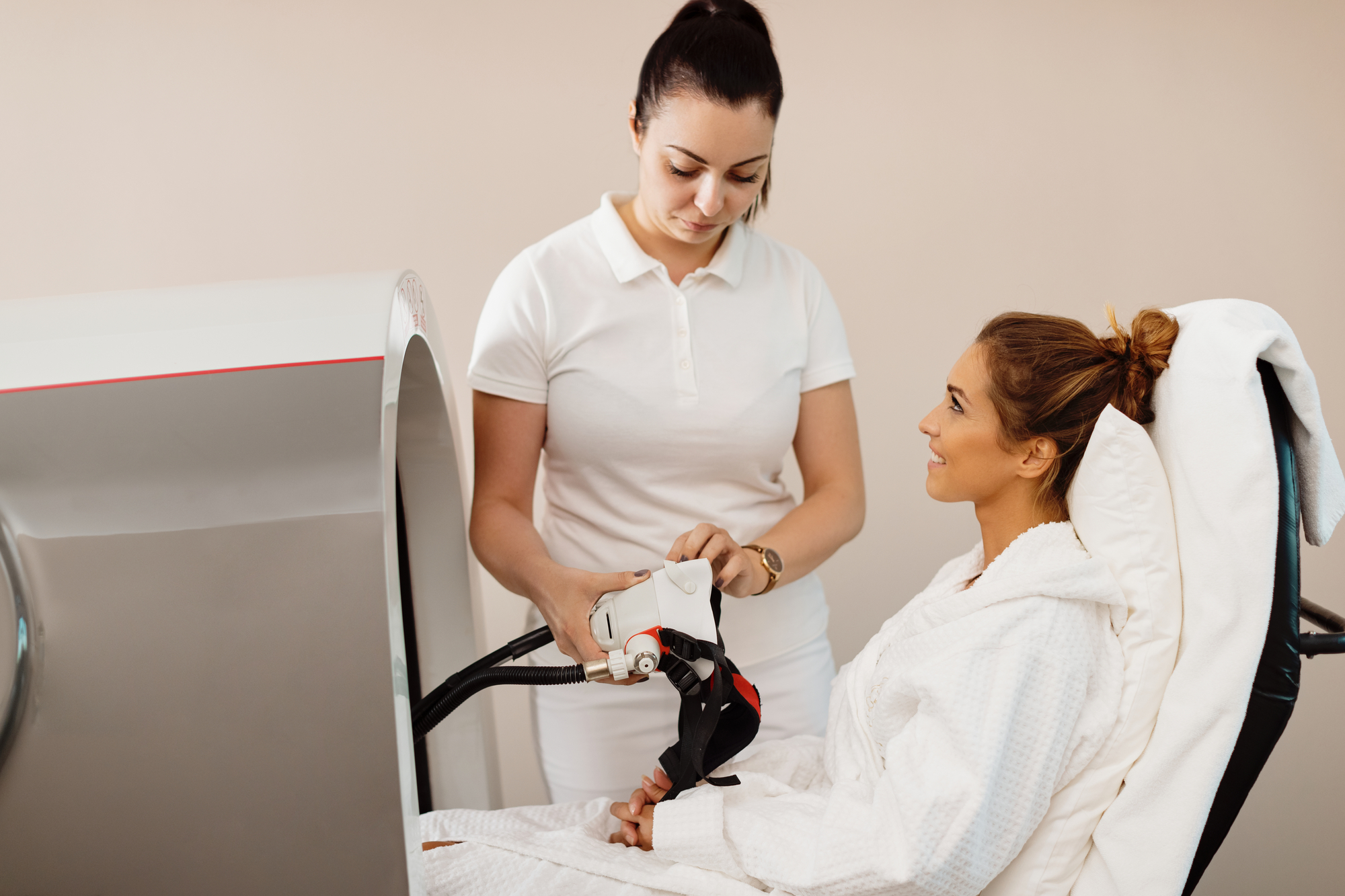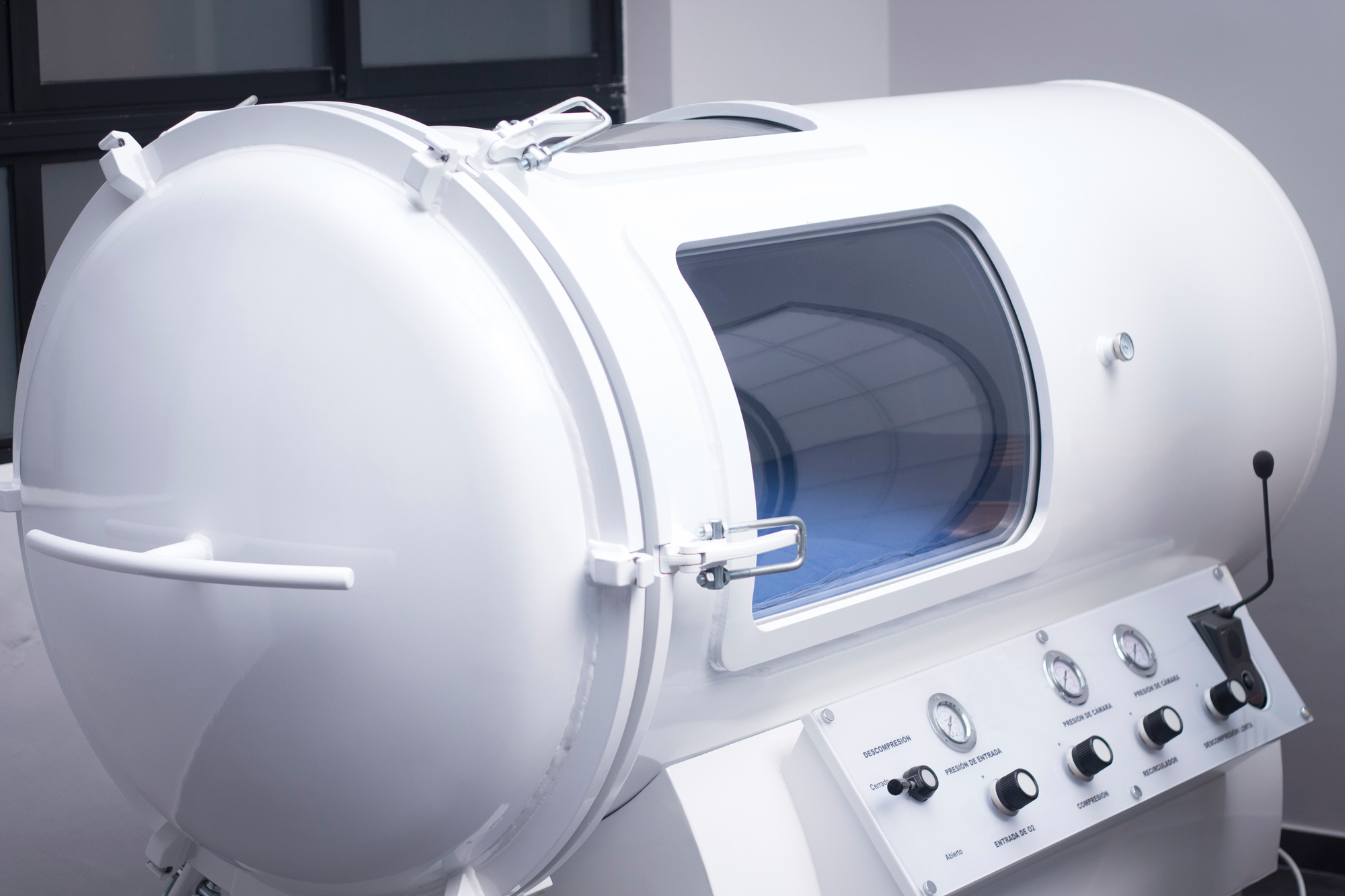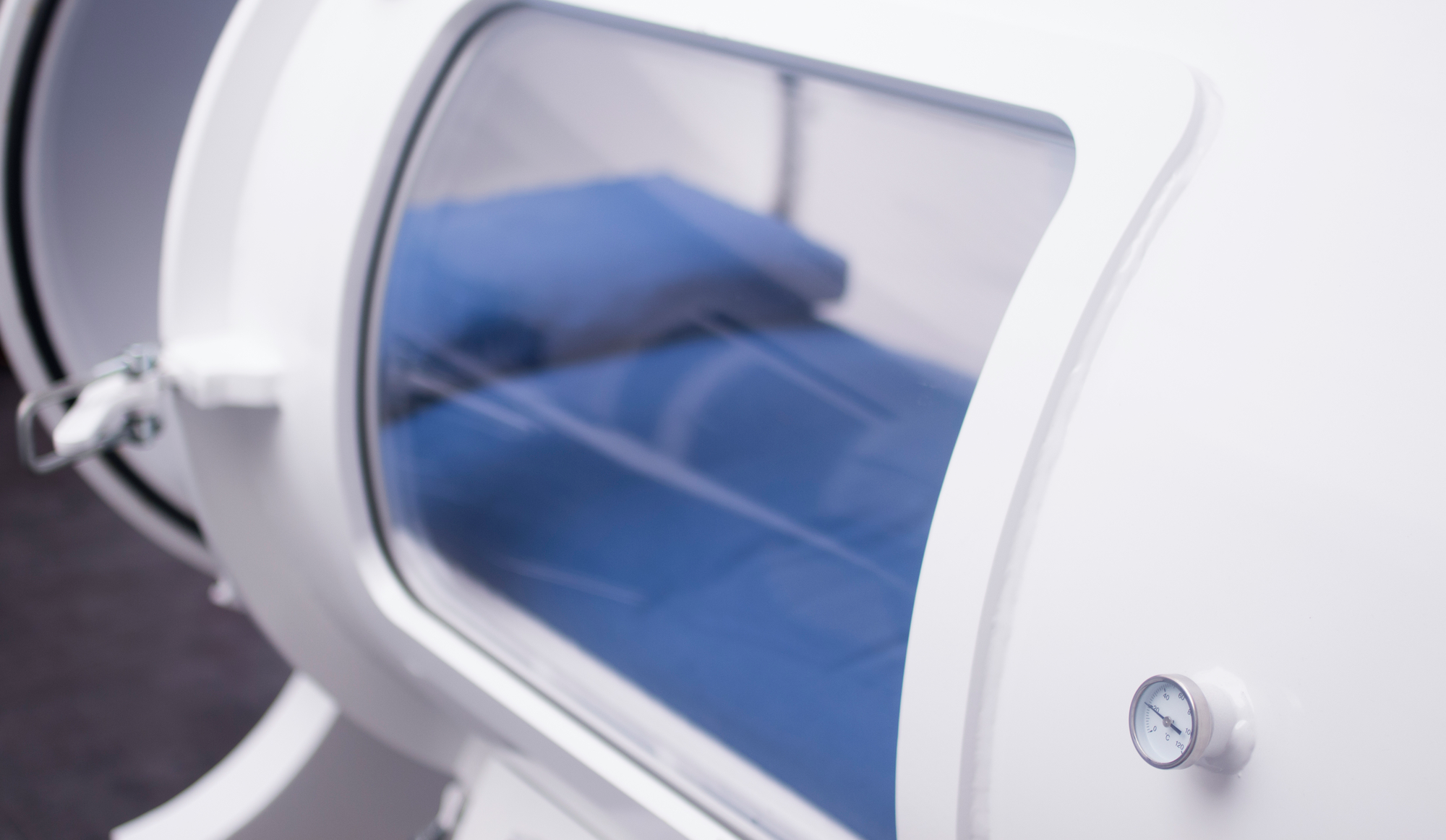
What is a Hyperbaric Chamber?
A hyperbaric chamber is a pressurized enclosure where you breathe in pure, 100 percent oxygen at levels higher than normal atmospheric pressure, allowing your lungs to gather more of this vital element than would be possible with the air outside at sea level.
The Undersea and Hyperbaric Medical Society (UHMS) defines HBOT as a patient breathing only oxygen at pressures of 1.4 ATA (normal ambient pressure at sea level) or higher.
Hyperbaric chambers come in different sizes and models, but the two most common are monoplace and multiplace, which respectively means for one person or multiple.
Diving Into the Definition of Hyperbaric Oxygen Therapy
Hyperbaric oxygen therapy involves a patient breathing pure oxygen in a pressurized chamber, allowing the lungs to gather more oxygen than normal. This increased oxygen level in your blood has a range of potential benefits, like promoting wound and injury healing and even helping fight certain infections.
New research has found more potential benefits from hyperbaric oxygen therapy, such as boosting energy levels, improving athletic performance, or enhancing overall well-being.
Understanding the uses and effects of hyperbaric oxygen therapy can empower you or any patient to make informed decisions about incorporating this treatment into your healthcare routine.
The Many Therapeutic Benefits of a Hyperbaric Chamber
The FDA has approved HBOT for 14 different types of medical treatments, with proven results after decades of research and application of oxygen therapy. This includes healing damaged tissue, treating gas embolism and infections, and even curing radiation injury or tissue damage from radiation therapy.
At ReEnergized, we've applied this proven technology to boost the wellness and overall health of our patients and also improve their long-term health outcomes with these benefits.
Increases Blood Oxygen Level
Breathing within this atmosphere boosts the oxygen concentration in the lungs, facilitating its delivery to the blood. This enables the oxygen to be carried to regions where circulation is reduced or obstructed.
This treatment is particularly beneficial for individuals with certain medical conditions that affect oxygen delivery to tissues, such as carbon monoxide poisoning, cyanide poisoning, and chronic wounds such as diabetic foot ulcers and other non-healing or problem wounds. Especially when it comes to wound care, Hyperbaric oxygen therapy can provide added care and help when wounds don't necessarily follow conventional treatments for healing.
This increased oxygen level in your blood can enhance cellular function, reduce inflammation, and support the body's natural healing processes.
Increases Energy
Through sessions in a chamber, you may find that your energy levels rise, allowing you to tackle daily activities with increased vigor and vitality. This is because oxygen is a key player in ATP (Adenosine triphosphate) production, which is the source of energy in every cell of our bodies. So, when oxygen concentration is increased, it helps our cells with more ATP.
This boost in energy can be particularly beneficial for individuals dealing with conditions that cause fatigue or lethargy.
Stimulates New Blood Vessel Growth
Stimulates Growth Factors & Stem Cells
When undergoing hyperbaric oxygen therapy, your body is prompted to release nitric oxide, a growth factor that mobilizes stem cells. This process plays a crucial role in enhancing your overall wellness and vitality.
Releasing more stem cells into your body can result in an 8-fold increase in mesenchymal and CNS stem cells, along with more vascular endothelial growth factors. This is crucial in tissue repair and blood vessel formation, promoting healing from within. Simultaneously, the mobilization of stem cells aids in the repair of damaged tissues and enhances your body's natural ability to recover.
Increases Infection & Injury Recovery
By exposing your body to increased atmospheric pressure within the chamber, oxygen dissolves more efficiently in your bloodstream, promoting faster healing of wounds and injuries. This boost in oxygen delivery also helps combat infections by aiding the white blood cells in your immune system in fighting off harmful bacteria or anaerobic pathogens.
Whether you're recovering from a sports injury or a stubborn soft skin infection, the hyperbaric chamber accelerates your healing journey, allowing you to get back to your active lifestyle sooner.
Decreases Blood Oxygen Size
Increasing pressure in the environment in which the oxygen is delivered decreases the size of their molecules, allowing for more delivery of oxygen to blood plasma.
The oxygen-rich environment created by this device promotes faster healing and recovery, making it an ideal solution for conditions like burn injuries. By visiting a hyperbaric facility, you can harness the healing power of higher plasma oxygen concentration to enhance your overall well-being.
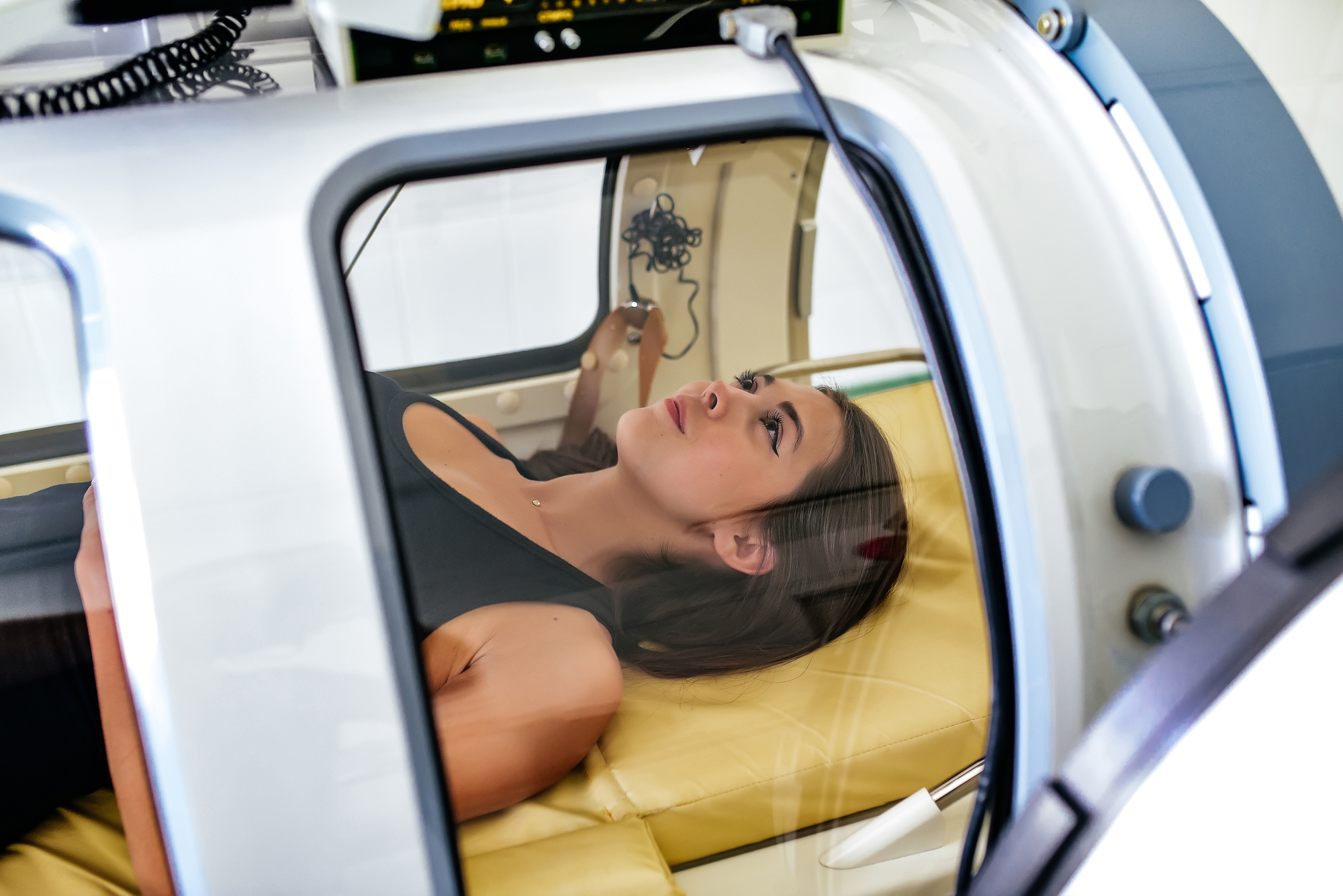
Common Medical Conditions Treated With Hyperbaric Oxygen
Hyperbaric medicine is not something new. It has long had serious medical applications by health care teams or in hospitals. As mentioned above, the FDA has approved the use of HBOT for several medical conditions, including, but not limited to:
-
- Diabetic wounds from high blood sugar.
- Carbon monoxide poisoning.
- Retinal artery occlusion (vision loss due to blockage of blood flow to the retina of one eye.)
- Severe burns.
- Fighting bone infections.
- Healing soft tissue radionecrosis (damage to tissue from radiation therapy.)
- Refractory osteomyelitis.
- Severe anemia when blood transfusions aren't viable.
- Air or gas embolism.
- Crush injury and other acute traumatic ischemias (low blood supply)
- Decompression sickness
- Failed skin grafts or flaps.
- Soft tissue infections.
Talk to your health care provider before deciding if HBOT is right for these conditions. Insurance companies also require you to consult with your healthcare provider if you want these treatments to be covered by your insurance.
The Science Behind Hyperbaric Oxygen Therapy
Understanding the Role of Pressurized Oxygen
Three physics laws are key to understanding this:
-
- Boyle's law, which states that at constant temperature, a gas' volume and pressure are inversely proportional.
- Henry's law states how the amount of gas in a liquid or tissue is proportional to the partial pressure of gas in contact with that tissue or liquid. This law is applied constantly in manufacturing carbonated drinks, for example.
- Dalton's law, which states that the total pressure exerted by a mixture of gases is equal to the sum of the partial pressures of the gases in the mixture.
So, this is how we know that raising the pressure of oxygen in a hyperbaric chamber allows your lungs to gather more of it than breathing pure oxygen at normal air pressure. Breathing oxygen under pressure allows it to be dissolved more easily into plasma.
Normal conditions typically do not allow plasma to carry oxygen, which is something done by red blood cells and hemoglobin. However, this high concentration of oxygen allows it to be distributed throughout your body, promoting tissue repair and reducing inflammation. The high oxygen content also stimulates the release of growth factors and stem cells, which further aid in the healing process.
Exploring the Different Types of Hyperbaric Oxygen Chambers
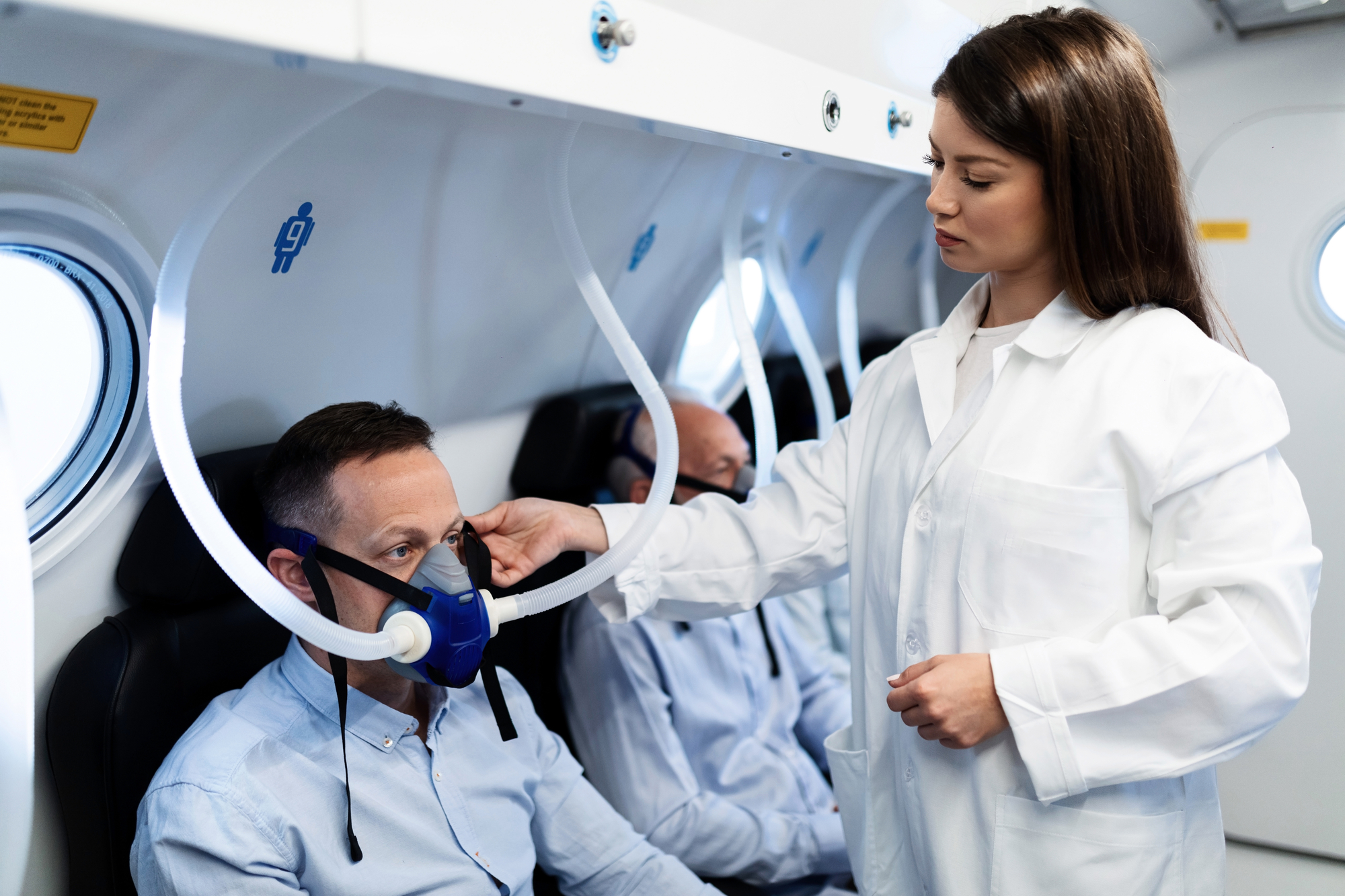
Understanding the Role of Pressurized Oxygen
When considering hyperbaric oxygen therapy, exploring the different types of chambers, such as monoplace chambers for individual treatment, can provide insight into the personalized treatment options available.
Monoplace chambers are designed for one person at a time, offering privacy and solitude during the therapy session. These chambers are beneficial if you prefer a more intimate setting or have specific needs that require individual attention. The enclosed environment allows for concentrated oxygen delivery at increased pressures, promoting the body's healing process.
In a monoplace chamber, you have the freedom to focus solely on your treatment without distractions. Whether you seek relaxation or targeted therapy, these chambers cater to your individual preferences, tailoring your hyperbaric oxygen therapy experience to your needs.
Multiplace Chambers for Group Sessions
In a multiplace chamber, you can relax, chat, or even meditate together with friends or family while receiving the benefits of hyperbaric oxygen therapy. This setting allows for a shared experience, fostering a sense of community and support among participants and also helping deal with possible claustrophobia.
If you value social interactions and prefer undergoing therapy in a group setting, multiplace chambers provide an ideal solution for your hyperbaric oxygen therapy needs
How to Prepare for Your First Hyperbaric Oxygen Therapy Session
What to Wear and What to Bring
To ensure a comfortable and successful first hyperbaric oxygen therapy session, it's important to know what clothing and items you should wear and bring with you.
Wear comfortable, loose-fitting clothing without any metal, like zippers or buttons, as these aren't allowed inside the chamber. Opt for cotton or other natural fabrics.
Many wellness studios offer cotton gowns or even require you to wear them and not your own clothing.
Avoid wearing perfumes, lotions, or hair products that contain oil, as they can be flammable in a high-oxygen environment.
Steps to Take Before Entering the Chamber
- Remove items: Don't go in with items that aren't allowed inside the chamber, such as perfumes, lotions, and electronics.
- Drink plenty of water: It's vital to stay hydrated before your session, so drink plenty of water. Remember to use the restroom beforehand to avoid any discomfort during the hyperbaric oxygen treatment.
- Be punctual: Arrive on time to complete any necessary paperwork and allow yourself to relax before entering the chamber.
- Ask any question you have: Communicate any concerns or questions you may have with the staff to ease any anxieties.
- Wear a grounding bracelet: If you're not provided one, it is recommended you avoid static electricity by wearing an anti-grounding bracelet.
Experiencing the Hyperbaric Oxygen Therapy Session
It's also important to know what you can expect in terms of sensations and sounds, if you can leave the chamber or not, and how you'll feel afterward.
How to Go Through the Treatment Process
Navigating through a hyperbaric oxygen therapy session at ReEnergized wellness center involves a step-by-step process for optimal experience.
- First, you'll be briefed on safety protocols and asked to remove any items that could spark in the chamber.
- Then, you'll enter the hyperbaric chamber, where the pressure will slowly increase to the prescribed level.
- During the session, you can relax, read, or listen to music while oxygen surrounds you.
- Once the session ends, the pressure will gradually return to normal. You might feel a slight sensation in your ears, like when ascending in an airplane.
Bring any necessary medical devices, like inhalers, with you. It's also recommended to bring something to keep you entertained during the session, like a book or music player, as you'll be in the chamber for a period of time.
After the treatment, you're free to resume your day feeling rejuvenated and refreshed.
What Will You Feel During Therapy?
You'll experience a gentle increase in air pressure as you relax in the hyperbaric oxygen therapy chamber. As the air pressure builds, you might feel a slight fullness in your ears, similar to the sensation when ascending or descending in an airplane. This is normal and can be relieved by swallowing gently or yawning.
Once the chamber reaches the desired air pressure, you may notice a soothing feeling of warmth surrounding you. Many people find this experience calming and use the time to meditate, listen to music, or simply unwind.
Throughout the session, you're free to move around, adjust your position, or close your eyes to fully embrace the relaxing atmosphere.
Can you take air breaks? Yes, but only in longer sessions. Nonetheless, every clinic, wellness studio, and hospital using a hyperbaric chamber allows patients to let themselves out earlier if they wish. It's not a prison.
Contact Us And Book an Appointment
To schedule your hyperbaric oxygen therapy treatment session, please get in touch with us to book an appointment. At ReEnergized, we value your time and want to make the booking process as easy as possible for you. Simply give us a call, shoot us an email, or visit our website to secure your spot for this rejuvenating experience. Our friendly staff is ready to assist you in finding the most convenient time slot for your session.
We understand that life can be hectic, so we offer flexible scheduling options to accommodate your busy schedule. Whether you prefer morning sessions to kickstart your day or evening appointments to unwind after work, we strive to meet your needs. Let us know your preferences, and we'll do our best to make it work for you.
Don't hesitate to reach out with any questions or special requests you may have regarding your hyperbaric oxygen therapy session. Your wellness journey is important to us, and we're here to support you every step of the way. Get in touch today to book your appointment and take the first step towards feeling re-energized!
